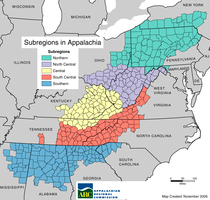 | Back to e-WV
| Back to e-WV
 The West Virginia Encyclopedia
The West Virginia Encyclopedia
 | Back to e-WV
| Back to e-WV
 The West Virginia Encyclopedia
The West Virginia Encyclopedia

The Appalachian Regional Commission was established by Congress in 1965 to bring Appalachia into the mainstream of the American economy. As defined by the Commission, the 200,000-square-mile region includes 420 counties in 13 states. All of West Virginia is included, as well as parts of Alabama, Georgia, Kentucky, Maryland, Mississippi, New York, North Carolina, Ohio, Pennsylvania, South Carolina, Tennessee, and Virginia.
President Lyndon Johnson signed the Appalachian Regional Development Act on March 9, 1965, but its origin can be traced back to President John F. Kennedy. During his pivotal primary campaign for president in West Virginia in 1960, Kennedy saw firsthand the despair in Appalachia, where one of every three families lived in poverty. The states’ governors formed the Conference of Appalachian Governors in 1960, and Kennedy kept a campaign promise by inviting the group to meet with him and top federal officials in Washington. The President’s Appalachian Regional Commission (PARC) was created, led by Franklin D. Roosevelt Jr. Following Kennedy’s assassination in 1963, the PARC recommendations were delivered to President Johnson, who saw that they were quickly transformed into enabling legislation.
The ARC federal-state partnership is embodied in its membership — the 13 Appalachian governors plus one federal representative, or federal co-chairman, appointed by the president and subject to Senate confirmation. Each year the governors elect one of their number to serve as the states’ co-chairman. The federal co-chairman has one vote on commission policy matters, and the governors, voting as a unit, share one vote. The commission appoints an executive director to head the ARC staff. Each governor names an alternate to handle ARC matters in his absence, and the states also employ a representative based in Washington who tracks ARC activities. West Virginia native and former First Lady Gayle Manchin currently serves as federal co-chair of the ARC.
ARC programs fall into two broad categories: (1) the Appalachian Development Highway System, a 3,571-mile corridor highway network intended to break the regional isolation created by mountainous terrain and thereby link Appalachian communities to national and international markets; and (2) an area development program to create a basis for sustained local economic growth. The development of six Appalachian Developmental Highways, or corridors, in West Virginia was the most visible accomplishment of the agency in the early years of its existence, complementing the new Interstate highway system that was built at about the same time.
The corridor from Morgantown east to the Maryland border in Preston County was converted to Interstate 68 but the others, all four-lane, limited-access expressways, remain part of the Appalachian corridor system. One connects Parkersburg to Clarksburg on U.S. 50; Corridor G stretches along U.S. 119 from Charleston southwest through Logan to Williamson and continues into Kentucky. Corridor L, which connects I-77 at Beckley to I-79 near Sutton via U.S. 19 through Summersville, includes a bridge over the New River that is the longest steel arch bridge in the United States. The other two are a short stretch of U.S. 460 through the state’s southernmost region and the still unfinished Corridor H. Despite controversy, additional sections of Corridor H have been opened. It is now complete from the Weston exit of I-79 to Kerens, Randolph County, about 41 miles. A segment of approximately 66 miles from Davis to Wardensville in Hardy County is also open. Plans are to extend Corridor H from Wardensville to the Virginia border near Strasburg, Virginia. The Appalachian Development Highway System (ADHS) is more than 90 percent completed with 3,090 miles open to traffic or under construction. The estimated cost of completion has been set at $9.7 billion.
Since its founding in 1965, the ARC has spent about $4.5 billion on various projects in Appalachia.
Written by Tom D. Miller
Bradshaw, Michael J. The Appalachian Regional Commission: Twenty-five Years of Government Policy. Lexington: University Press of Kentucky, 1992.
Appalachia. Journal of the Appalachian Regional Commission, (Winter-Spring 1995).
1997 Annual Report. Appalachian Regional Commission. Washington: Appalachian Regional Commission, 1998.